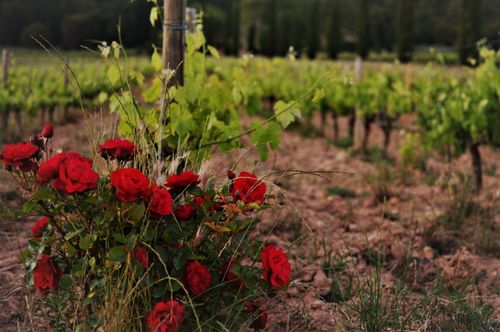As you travel through Italy’s renowned wine regions, you can’t help but notice a charming detail that adds to the beauty of the vineyards: rose plants placed at the head of the vine rows. This pairing, which may seem purely decorative, actually has a long agricultural tradition and a significance that goes beyond aesthetics. In fact, roses are not just ornamental plants but valuable allies in maintaining vineyard health and symbols of the deep connection between humans and nature.
The Practical Function of Roses in Vineyards
In the past, roses in vineyards served an essential function. In addition to beautifying the fields, they were planted to mark the end of the rows, making it easier for draft animals such as oxen and horses to navigate. During maneuvers, these animals could easily damage the vine plants, but the presence of robust and highly visible roses helped guide them without harming the crops.
However, the primary reason roses were considered indispensable lies in their role as "sentinel plants" or "indicator plants." Being more delicate than grapevines, roses were the first to show signs of pest attacks, fungal diseases, or nutrient deficiencies in the soil. This early warning system allowed winemakers to detect problems in advance and take timely action to protect vineyard health.
Pests and Diseases: A Valuable Help for Winemakers
Thanks to the sensitivity of roses, winemakers could monitor the presence of pests such as leafhoppers and red and yellow mites, which could cause significant damage to the vines. Similarly, roses signaled the onset of fungal diseases such as gray mold (botrytis), powdery mildew (also known as white mildew), and woolly root rot. If left untreated, these diseases could severely compromise both the quality and quantity of the harvest, making roses true allies in vineyard management.
Gray mold, for instance, is one of the most feared threats for viticulturists as it causes grape rot, hindering proper ripening. Powdery mildew appears as a white dust that discolors leaves and reduces their photosynthetic capacity, weakening the plant. Woolly root rot, on the other hand, affects the roots, covering them with a whitish network that prevents the plant from properly absorbing nutrients from the soil.
Roses Today: Between Tradition and Beauty
With advancements in agricultural techniques and the introduction of modern crop monitoring tools, the role of roses as "sentinel plants" is no longer essential. However, their presence in vineyards remains widespread, especially among winemakers who wish to keep tradition alive and preserve the natural balance of the environment. Roses are not merely decorative elements but symbols of respect for the biological cycles of vines and biodiversity.
Planting roses at the beginning of the rows is also a way to honor the past and enhance the agricultural landscape. Vineyards adorned with roses become a testament to the harmony between humans and nature, a union that not only enhances the beauty of the territory but also reflects the quality of the wines produced.
Rose Varieties in Italian Vineyards
Each wine region has developed a preference for specific rose varieties, often linked to local traditions and the types of wine produced. In Piedmont, for example, the Astesana rose, with its deep red hue, is commonly found in vineyards, echoing the shades of Barbera wine. In Moscato vineyards, the Dionisia rose, specially created for the Associazione Donne del Vino (Women of Wine Association), is widely used. This unique rose changes color depending on the climate and blooming stage, shifting from yellow-orange to bronze.
In Tuscany, the most common varieties include the Magliano rose, known for its abundant and fragrant bloom, and the Balzastrada rose, also known as Alba Maxima. The latter is particularly appreciated for its large white flowers and intense fragrance, making it a distinctive feature of vineyards in the Chianti area of Florence and Siena.
A Bond Between Beauty and Health
Roses in vineyards are not only useful and decorative but also a symbol of beauty and health. With their vibrant colors and enchanting fragrances, they enrich the landscape and serve as a reminder that viticulture is not just about technique but also about passion and respect for nature. This deep-rooted connection between roses and vines, grounded in tradition, continues to be a distinctive feature of Italian vineyards, blending aesthetics and functionality in a truly unique way.
